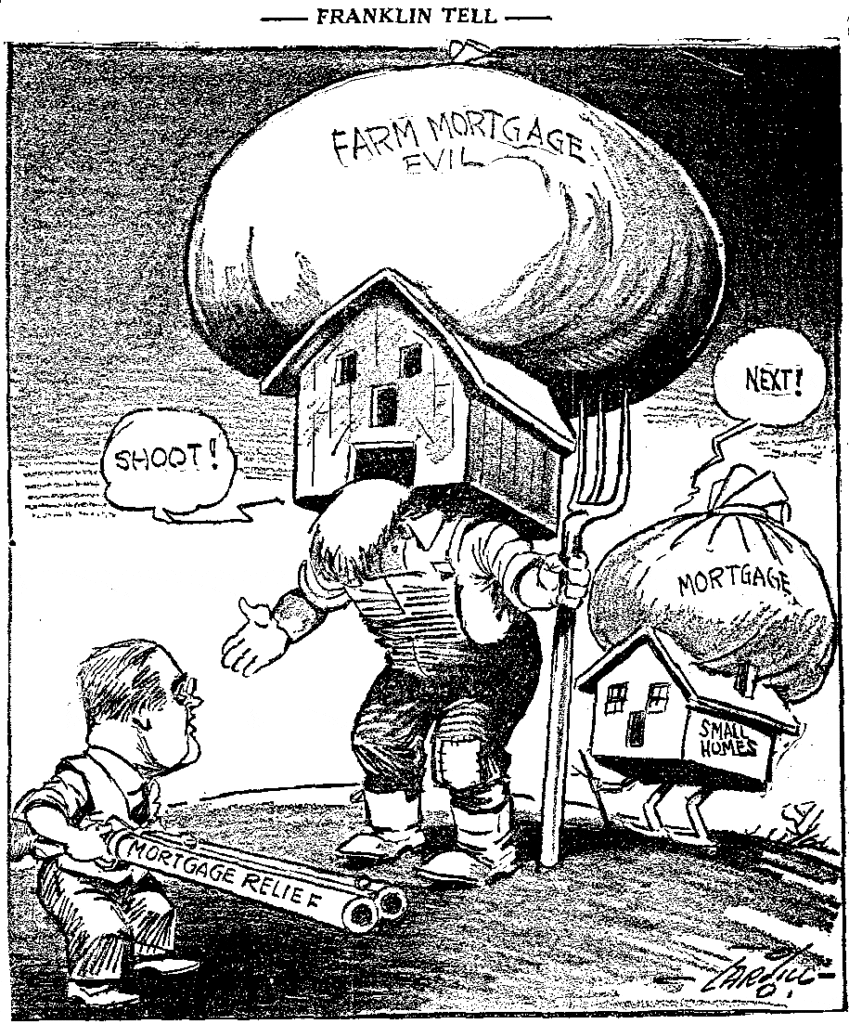When I was 16 years old, I visited the Production Credit Association (PCA) office in Lampasas, Texas to ask for a loan to buy 5 cows. This was to expand my SAE program. As a freshman, I had two Angora goats. During my sophomore year, I added more goats and had a flock of 20 sheep thanks to the FFA chapter livestock chain. In my junior year, I added more sheep and goats but wanted to add some cows. The PCA officials approved of the loan and I bought five cows and a bull to add to my SAE program.
I really didn’t think about why there was a Production Credit Association, why it was created, and how it operated. It was just there. I knew they loaned money to 4-H and FFA members for livestock projects.
A few years later I visited the local office of the Federal Land Bank to explore the possibility of borrowing money to buy the homeplace. I was in college at the time and my mother and three brothers had all moved to Ohio. I would spend most weekends checking on the livestock, fences, etc. before returning to campus 90 miles away. Eventually, I decided against buying the home place because I planned to be an agricultural teacher and the odds of getting a teaching job near home were slim and more acreage was needed to be sustainable.
I really didn’t know much about the Federal Land Bank other than they loaned money to purchase agricultural land. In this Friday Footnote, we will explore the various programs designed to loan money to farmers. At least one of the programs is over 100 years old.
What is the Production Credit Association?
According to Investopedia (Kenton, 2019):
A Production Credit Association (PCA) is a federal entity created through the Farm Credit Act of 1933 to provide short- and intermediate-term credit to farmers, ranchers, and rural residents. The credit was extended so the recipients could purchase housing, perform marketing activities, purchase farm equipment and livestock, and operate farm-related businesses. At the time, credit was either not available or was available only at prohibitively high interest rates because of the Great Depression. Farmland and commodities weren’t worth as much, and banks already had lots of agricultural loans on their books.
Production Credit Associations can make or guarantee loans whose terms do not exceed seven, 10, or 15 years, depending on the funding bank’s policies.
What is the Federal Land Bank?
Prior to the establishment of Production Credit Associations in 1933 Congress had passed the Federal Farm Loan Act of 1916. This act, based upon a long-running program in Germany, created a system of Federal Land Banks to provide long-term credit to farmers. The primary objective of this program was to loan money to farmers so they could buy land and/or expand their farms.
At the time this legislation was passed there was a scarcity of credit at reasonable interest rates and terms for farmers. The Act established 12 federal land banks in 12 districts across the country (in cities in which there was a Federal Reserve Bank). Hundreds of local branches were established to serve the needs of the farmers.
What is the Farm Credit Administration?
Shortly after taking office in 1933, President Franklin D. Roosevelt created the Farm Credit Administration with an Executive Order (No. 6084) on March 27, 1933. This Executive Order was designed to consolidate and streamline various federal efforts that dealt with farm credit into one administrative authority.

Figure 1. This cartoon shows President Roosevelt officiating a wedding of the Farmer with the Farm Credit Administration. The cartoon is by Halladay and appeared in the Providence Journal.
Several weeks later President Roosevelt (May 12) signed the Emergency Farm Mortgage Act. With banks going under (it is estimated that 9,000 banks failed in the 1930s including one in North Carolina that contained the state FFA funds) during the great depression this action was designed to lower interest rates and provide for more liberal terms in regards to loan repayments. This act was to be administered by the Farm Credit Administration.

Figure 2. In this cartoon labeled as Franklin Tell, FDR is going to shoot the overbearing mortgage off the farmer. This cartoon is by Cargill from the Cortland Standard.
President Roosevelt’s signed the Farm Credit Act of 1933 on June 16 (this was the 100th day into his administration). Not only did the Farm Credit Act of 1933 create Production Credit Associations it amended the Farm Loan Act of 1916 and it officially became a part of the FCA.
In 1929 Congress had passed the Agricultural Marketing Act to provide loans to farm cooperatives. This Act promoted agricultural cooperatives in an effort to stabilize farm prices, however, when farm prices fell in 1930, this program collapsed. One provision of the 1933 Farm Credit Act reestablished 12 regional banks for the purpose of loaning money to farm cooperatives. These cooperative banks were under the purview of the Farm Credit Administration.
By the end of the 1930s, it was “estimated that altogether about two million farmers [were] utilizing directly or indirectly the financing services of institutions operating under the Farm Credit Administration,” which had issued over $3,000,000,000 in credit, “representing from one-fourth to one-third of the total credit outstanding to agriculture from all sources” The FCA and the Farm Credit Act proved to be integral parts of the overall New Deal effort to save, stabilize and improve America’s farms – efforts which also included price controls, soil conservation, and rural electrification. And, as farming revived during and after World War II, most federal loans were repaid [Farm Credit Act, 1933).
Federal Legislation dealing with farm credit was reworked in 1953, was repealed in 1966, and evolved into the 1971 Farm Credit Act which is in place today.
The Farm Credit System Today
The Farm Credit Administration still operates today, as “an independent Federal agency that regulates and examines the banks, associations, and related entities of the Farm Credit System…a nationwide network of lending institutions that are owned by their borrowers. It serves all 50 States and Puerto Rico” (FCA in Brief, 2018).

The Farm Credit System has 72 lending associations serving the United States. Each association serves a specific territory and typically has several branch offices. To find the office nearest you there is a location locator at https://apps.fca.gov/Locator/. Just enter your zip code.
The names I grew up with, Production Credit Association and Federal Land Bank, are not commonly used today. Instead, the term Agricultural Credit Association (ACA) is used in regulatory documents but a variety of names are used at the local level. Some of these include AgCredit, Farm Credit, AgFirst, AgriBank, AgVantis, AgHeritage, and others. This link will take you to a list of the various associations. The images below are from Oklahoma, Arkansas, Vermont, and Kansas.




FCS associations are owned by the borrowers who purchase stock, which is required as part of their loans (the smaller of $1,000 or 2% of the loan amount). FCS stockholders elect the boards of directors for banks and associations. Each has one vote, regardless of the loan size. Most directors are members, but federal law requires at least one from outside. If an association is profitable, the directors may choose to retain the profits or distribute some of it through dividends or patronage refunds that are proportional to the size of the loan. Patronage refunds can effectively reduce the cost of borrowing. The image below shows that members of the Yosemite Farm Credit Association will get over 24 million in dividends this year.
 Concluding Remarks
Concluding Remarks
During the great depression, obtaining farm credit was important to the survival of American agriculture. The Farm Credit Act of 1933 and the creation of the Farm Credit Administration was as important to rural America as the other depression era acts such as the creation of the Soil Conservation Service and the Rural Electrification Administration.
The Farm Credit Act of 1933 indirectly helped me earn my American Farmer degree. The loan I received from the Production Credit Association to buy cattle contributed to enhancing my SAE program and reaching the monetary requirement needed. The good news is loans are still being made today to support our students.
The various Agricultural Credit Associations loan money (often interest free) to 4-H and FFA members today. Each FCS bank is required (by section 4.19) of the Farm Credit Act of 1971, to provide loans to young, beginning, and small farmers. One example of this youth loan program can be found at https://www.agloan.com/about-us/community-giving/agyouth-program/. This information is from American AgCredit, which operates in parts of California, Nevada, Colorado, Oklahoma, Hawaii, and Kansas. You should check with your local Agricultural Credit Association to learn more about the youth loan program.
Teaching Ideas
Invite a representative from your local Agricultural Credit Association (ACA) to speak to your classes or at an FFA meeting about the Farm Credit System and the youth loan program.
Have your students fill out the Youth Program Loan Application form from American AgCredit so they can see what type of information is needed. https://www.agloan.com/wp-content/uploads/2019/01/AgYouthProgramApplication_2018.pdf
Stage a mock interview where a student is meeting with a loan officer from an ACA. The student wants a loan. What type of questions should the student ask and be prepared to answer?
References
Farm Credit Act (1933). https://livingnewdeal.org/glossary/farm-credit-act-1933/
FCA in Brief,” Farm Credit Administration, http://www.fca.gov/about/fca_in_brief.html
Kenton, Will (2019). Production Credit Association. https://www.investopedia.com/terms/p/production-credit-association.asp
Rosenfel, Ross & Zavatsky (2020). Farm Credit Act of 1933. https://www.encyclopedia.com/history/encyclopedias-almanacs-transcripts-and-maps/farm-credit-act-1933
